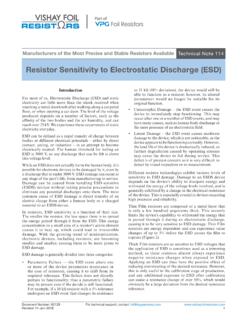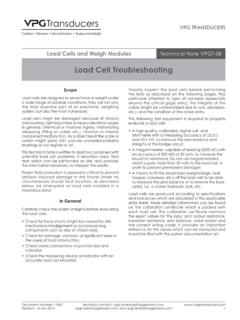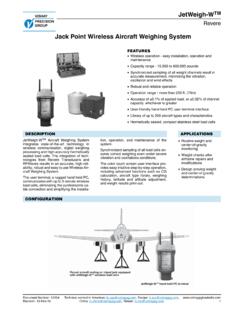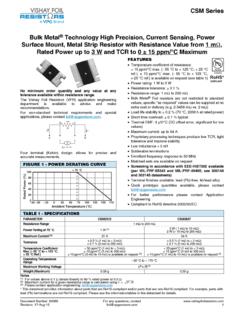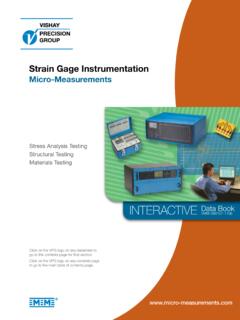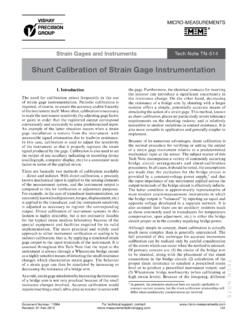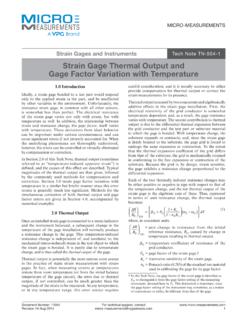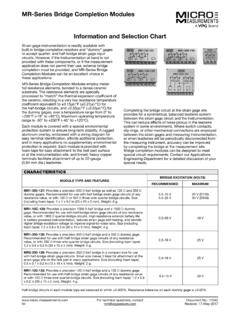Transcription of Z series (Z Foil) - Datasheet - VPG | Performance through ...
1 Any questions, contact No.: 63187 Revision: 01-Nov-2016Z series (Z Foil) Ultra High Precision Z foil Though- hole ResistorUltra High Precision Z foil Though- hole Resistorwith TCR of ppm/ C, Tolerance of (50 ppm), Load Life Stability of Temperature coefficient of resistance (TCR): ppm/ C typical ( 55 C to +125 C, +25 C ref.) (see table 1) Rated power: to 1 W at +125 C (see table 2) Resistance tolerance: to (50 ppm) Load life stability: at 70 C, 2000 h or at 70 C, 10000 h (see table 4) Resistance range: 5 to 600 k Bulk Metal foil resistors are not restricted to standard values; specific as required values can be supplied at no extra cost or delivery ( 1K2345 vs. 1K) Total accumulated change in resistance value over life or Total Error Budget < (or tighter with PMO)** Electrostatic Discharge (ESD): at least to 25 kV Non-inductive, non-capacitive design Rise time: 1 ns effectively no ringing Current noise: VRMS/V of applied voltage (< 40 dB) Thermal EMF: V/ C typical Voltage coefficient: <3 ppm/V Low inductance: < H typical Thermal stabilization time <1 s (to reach within 10 ppm of steady state value) Pattern design minimizing hot spots Terminal finish: lead (Pb)-free or tin/lead alloy Matched sets are available per request (TCR tracking.)
2 To ppm/ C) Military established reliability R level resistor available (see resistor model RNC90Z) Screen/test flow as modified from S-311-P813 proposed by NASA available (see Datasheet for resistor model 303143) Prototype quantities available please contact Bulk Metal foil resistor is based on a special thermo-metalic stress concept wherein a proprietary bulk metal cold rolled foil is cemented to a ceramic substrate. It is then photoetched into a resistive pattern. Then it is laser adjusted to any desired value and tolerance. Because the metals used are not drawn, wound or mistreated in any way during manufacturing process, the Bulk Metal foil resistor maintains all its design, physical and electrical characteristics while winding of wire or sputtering does not.
3 Z foil resistors achieve maximum stability and near-zero TCR. These Performance characteristics are built-in for every unit, and do not rely on screening or other artificial means for uniform stability of a resistor depends primarily on its history of exposures to temperature. Stability is affected by:1. Reversible changes in the ambient temperature and heat from adjacent components (defined by the Temperature Coefficient of Resistance, or TCR)2. Short-term steady-state self-heating (defined by Power TCR or PCR)3. Irreversible destabilizing shock of suddenly-applied power4. Long-term exposure to applied power (load-life stability)In very high-precision resistors, these effects must be taken into account to achieve high stability with changes in load (Joule Effect) and ambient foil Resistors Z foil technology provides an order of magnitude reduction in the Bulk Metal foil element s sensitivity to temperature changes both external and internal.
4 This technology provides TCR of ppm/ C typical (military range: 55 C to +125 C, +25 C ref), and a PCR of 5 ppm at rated order to take full advantage of this TCR improvement, it is necessary to take into account the differences in the resistor s response to each of the above-mentioned effects. The Z series has been developed to successfully deal with these factors.* This Datasheet provides information about parts that are RoHS-compliant and/or parts that are non-RoHS-compliant. For example, parts with lead (Pb) terminations are not RoHS compliant. Please see the information/tables in this Datasheet for details.** See PMO page 5 Document No.: 63187 Revision: 01-Nov-2016Z series (Z Foil) TABLE 1 TYPICAL TCR AND MAX.
5 SPREAD( 55 C to +125 C, +25 C ref.)VALUESTANDARD TOLERANCETYPICAL TCR AND MAX. SPREAD (ppm/ C)100 to 600 k to <100 to <80 0. 2 to <50 0. 2 to <25 to <10 series (Z Foil) For any questions, contact No.: 63187 Revision: 01-Nov-2016Z series (Z Foil) FIGURE 1 TYPICAL RESISTANCE/ TEMPERATURE CURVE(for more details, see table 1)+500 +200 +100 0 100 200 300 500 RR(ppm) ppm/ C ppm/ ppm/ C ppm/ C ppm/ C ppm/ C 400 +300 +400 Ambient Temperature ( C) TCR Values for Different Temperature Ranges 25+250+60+75+100+125 55 NoteThe TCR values for <100 are influenced by the termination composition and result in deviation from this curveFIGURE 2 POWER DERATING CURVE1007550250- 75- 50- 250+ 25+ 50+ 75+ 100+ 125+ 150+ 175+ 200 Ambient Temperature ( C) Rated Power (%) at + 70 - 55 C+ 70 CRated PowerFIGURE 3 TRIMMING TO VALUES (conceptual illustration)
6 Mutual InductanceReduction dueto Change inCurrent DirectionCurrent PathBefore TrimmingFoil shown in black, etched spaces in whiteInterloop CapacitanceReduction in SeriesTrimming ProcessRemoves this Materialfrom Shorting Strip AreaChanging Current Pathand IncreasingResistanceCurrent Path After TrimmingNoteTo acquire a precision resistance value, the Bulk Metal foil chip is trimmed by selectively removing built-in shorting bars. To increase the resistance in known increments, marked areas are cut, producing progressively smaller increases in resistance. This method reduces the effect of hot spots and improves the long-term stability of Bulk Metal foil 4 - through - hole STYLE (29 YEARS) R/R (ppm)Time (Years) any questions, contact No.
7 : 63187 Revision: 01-Nov-2016Z series (Z Foil) FIGURE 5 STANDARD IMPRINTING AND DIMENSIONSWLead Material #22 AWG RoundSolder Coated Copper Optional Customer Part Number Print Specification, etc., if RequiredRear View ResistanceValue CodeTo NumberVFRXXXXST1)HLDate CodeFront View10 Week10 YearZ201 Note1. The standoffs shall be so located as to give a lead clearance of in minimum between the resistor body and the printed circuit board when the standoffs are seated on the printed circuit board. This is to allow for proper cleaning of flux and other contaminants from the unit after all soldering 2 MODEL SELECTIONMODEL NUMBERRESISTANCE RANGE (2) MAXIMUM WORKING VOLTAGEAMBIENT POWER RATINGAVERAGE WEIGHTDIMENSIONSat +70 Cat +125 CINCHESmmZ201(Z201L) (1)5 to 100 k 300 gW: L: H: ST: min.
8 SW: LL: LS: (1) min. 1. 0 2 0 .13 3 . 81 0 .13Z2045 to 200 k 350 gW: max. L: max. H: max. ST: SW: LL: LS: max. max. max. 1. 27 0 .13 to 300 k 350 gW: max. L: max. H: max. ST: SW: LL: LS: max. max. max. 1. 27 0 .13 to 600 k 500 gW: max. L: max. H: max. ST: SW: LL: LS: max. max. max. 1. 27 0 .13 to Wover 400 KNote(1) in ( mm) lead spacing available specify Z201L instead of Z201.(2) For non standard values please contact Application Engineering at series (Z Foil) For any questions, contact No.: 63187 Revision: 01-Nov-2016Z series (Z Foil) TABLE 3 ENVIRONMENTAL Performance COMPARISONMIL-PRF-55182 CHAR JZ series TYPICAL RZ series MAXIMUM R (1)Test Group I Thermal shock, 5 ( 65 C to +150 C) Short time overload, rated power (20 ppm) (30 ppm) (100 ppm) (100 ppm)Test Group II Resistance temperature characteristics Low temperature storage (24 h at 65 C) Low temperature operation (45 min, rated power at 65 C) Terminal strength 25 ppm/ C 0.
9 15% 0 .15% ppm/ C (20 ppm) (20 ppm) (20 ppm) see table 1 (100 ppm) (100 ppm) (100 ppm)Test Group III DWV Insulation resistance Resistance to solder heat Moisture resistance 0 .15% 104 M 0 .10% (20 ppm) (50 ppm) (100 ppm) (100 ppm) 104 M (100 ppm) (200 ppm)Test Group IV Shock Vibration (20 ppm) (20 ppm) (100 ppm) (100 ppm)Test Group V Life test at rated power / +125 C 2 000 h10 000 h (50 ppm) (150 ppm) (150 ppm) (500 ppm)Test Group Va Life test at 2 rated power / +70 C, 2 000 h (50 ppm) (150 ppm)Test Group VI High temperature exposure (2 000 h at +175 C) (200 ppm) (500 ppm)Test Group VII Voltage coefficient 5 ppm/V 3 ppm/V(1) Measurement error allowed for R limits: STANDARD OPERATIONS AND TEST CONDITIONSA.
10 Standard Test OperationsBy 100% Inspection: TCR Short-time overload ( rated power for 5 s) Resistance tolerance check Visual and mechanicalBy Sample Inspection: Environmental tests per table 3 on a quarterly basis to establish Performance by similarityB. Test Conditions Lead test point: in ( mm) from resistor body Temperature: +23 C 2 C Relative humidity: per MIL-STD-202 LONG-TERM STABILITYSome process controls are not very critical but many, many are particularly when a process is operating near a tipping point where it could get out of control quickly if not well process control applications, entire production batches have been lost or suffered reduced reliability when critical parameters were not kept within narrow limits.
